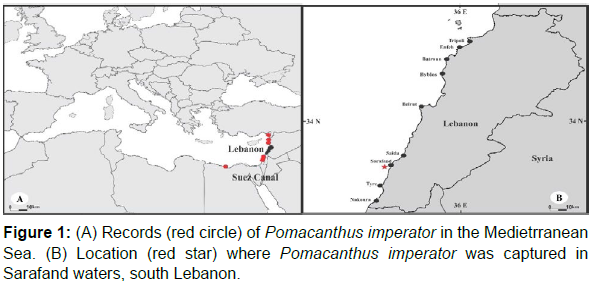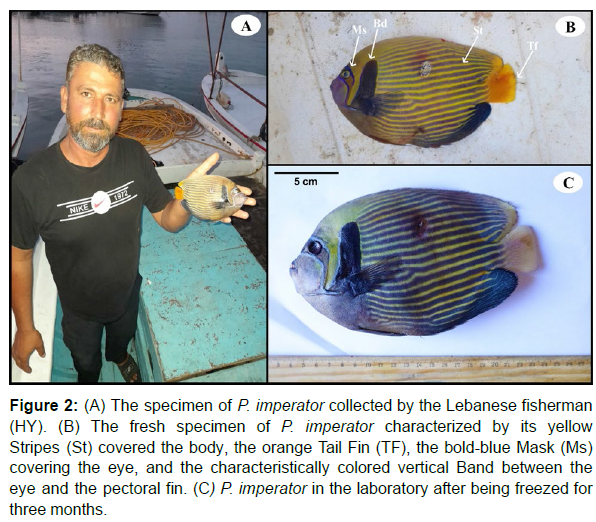First Record of the Emperor Angelfish Pomacanthus Imperator (Bloch, 1787) from the Lebanese Water (Eastern Mediterranean)
Received: 14-Mar-2023 / Manuscript No. JFLP-23-91552 / Editor assigned: 16-Mar-2023 / PreQC No. JFLP-23-91552(PQ) / Reviewed: 30-Mar-2023 / QC No. JFLP-23-91552 / Revised: 04-Apr-2023 / Manuscript No. JFLP-23-91552(R) / Accepted Date: 06-Apr-2023 / Published Date: 11-Apr-2023 DOI: 10.4172/2332-2608.1000405
Short Communication
Pomacanthus imperator, known as the emperor angelfish, belongs to the family Pomacanthidae, which inhabits tropical and subtropical waters worldwide [1, 2]. P. imperator occurs in many localities of the Indian and Pacific oceans [3].
In the Mediterranean Sea, P. imperator was reported from its southern Levantine Sea for the first time in 2010 [4]. Subsequently, it has been reported again from the same area [5], and from the Syrian [6, 7], Turkish [8], and Egyptian [9] waters. However, until today, only the non-indigenous lessepsian Pomacanthus maculosus was reported from the Lebanese waters [10]. Therefore, this note constitutes the first record of the non-indigenous P. imperator in Lebanese waters.
On 22th August 2022, a specimen of P. imperator was caught by spearfishing at a depth of 40 m off a sandy bottom in Sarafand (33°27’59.89”N; 35°16’43.25”E, Figure 1). Photo of the captured specimen were sent by the fisherman (HY) to one of the authors (AB). Subsequently, the specimen was collected for analysis and identification following the morpho-chromatic and meristic characteristics reported by [4]. The specimen of P. imperator is currently preserved in the Institute of the Marine Protected Area of Tyre Coast Nature Reserve (TCNR), with code LEBSPI1 (Figure 1).
The specimen photographed and collected from the Lebanese waters is similar to the ones described from other countries of the Levantine Sea [1, 4, 6, 8].
P. imperator is an eye-catching species and can be easily identified. It is characterized by its oval body, distinguished by its body color: covered with bright yellow horizontal stripes, and ended by an orange tail fin. In addition, a particular bold blue-black mask covers the eyes, and a similarly-colored vertical band extends from the pectoral fin two-thirds of the way up the body (Figure 2). The collected specimen showed a total length of 184 mm. D: XVI + 20; A: III + 19; P: I + 5 (Table 1).
Figure 2: (A) The specimen of P. imperator collected by the Lebanese fisherman (HY). (B) The fresh specimen of P. imperator characterized by its yellow Stripes (St) covered the body, the orange Tail Fin (TF), the bold-blue Mask (Ms) covering the eye, and the characteristically colored vertical Band between the eye and the pectoral fin. (C) P. imperator in the laboratory after being freezed for three months.
| Morphometric Measurements (in mm) | |
|---|---|
| Specimen 1 | |
| Total length | 184 |
| Standard length | 166 |
| Head length | 56 |
| Pre-anal length | 90 |
| Maximum height | 115 |
| Eye diameter | 9 |
| Meristics | |
| Dorsal fin spines | 12 |
| Dorsal fin rays | 20 |
| Pectoral fin rays | 18 |
| Anal fin spines | 3 |
| Anal fin rays | 19 |
| Caudal fin rays | 17 |
| Pelvic fins | 6 |
Table 1: Meristic and morphometric characters of Pomacanthus imperator collected along the Mediterranean coast of Lebanon.
Recently, the number of new marine species records, especially non-indigenous ones, has been increasing along the Lebanese coast [11, 12]. This is because scientific campaigns linked with citizen science support detecting non-indigenous species and recording such rare species. Accordingly, with this new record, the number of NIS fish in the Lebanese waters reaches a number of 98 species [10, 12].
The introduction of P. imperator in the Mediterranean Sea still needs to be clarified [5]. However, whatever the vector of introduction (e.g., aquarium release/ or Suez Canal), P. imperator started to be established in the Levantine Sea with eight records confirmed and published. In this context, this new invader’s ecology and distribution status should be followed up, knowing its omnivorous diet, feeding on small invertebrates and plants.
From a monitoring, protection, and conservation point of view, there is an urgent need to establish an updated checklist of the NIS along the Lebanese coast. Indeed, ensuring long-term monitoring (focusing on citizen science) of NIS is recommended to evaluate and anticipate the impacts on the local communities.
Acknowledgement
The authors thank the fisherman, Mr. Hasan Younes, for his cooperation.
References
- Fricke HW (2008) Juvenile-adult color pattern and coexistence in the territorial coral reef fish Pomacanthus Imperator. Mar Ecol 1: 133-141.
- Fricke R, Eschmeyer WN, Fong JD (2019) Species by Family/Subfamily.
- Randall JE (2007) Reef and shore fishes of the Hawaiian Islands. Honolulu: University of Hawai'i Press.
- Golani D, Salameh P, Sonin O (2010) First record of the Emperor angelfish, Pomacanthus imperator (Teleostei: Pomacanthidae) and the second record of the spotbase burrfish Cyclichthys spilostylus (Teleostei: Diodontidae) in the Mediterranean. Aquat Invasions 5(Suppl 1): S41-S43.
- Stern N, Badreddine A, Bitar G, Crocetta F, Deidun A, et al. (2019) New Mediterranean Biodiversity Records 2019. Mediterr Mar Sci 20: 409-426.
- Capapé C, Ali M, Ali A, Esmail A (2018) Second Mediterranean record of Emperor angelfish, Pomacanthus imperator (Osteichthyes: Pomacanthidae), and first record from the Syrian coast. Cahiers De Biologie Marine 59: 395-397.
- Saad A, Alkusairy H, Sabour W (2018) First record of the Emperor angelfish, Pomacanthus imperator (Acthenoptergii: Pomacanthidae) in the Syrian coast (Eastern Mediterranean). Mar Biodivers Rec 11: 1-4.
- Gurlek M, Erguden D, Burcu A, Turan C (2019) First record of Pomacanthus imperator (Bloch, 1787) from Turkish marine waters. NE Sciences 4: 231-236.
- Al Mabruk SA, Abdulghani A, Nour OM, Adel M, Crocetta F, et al. (2021) The role of social media in compensating for the lack of field studies: Five new fish species for Mediterranean Egypt. J Fish Biol 99: 673-678.
- Michel B, Fricke R (2020) The marine ichthyofauna of Lebanon: an annotated checklist, history, biogeography, and conservation status. Zoo taxa 4775: 1-157.
- Badreddine A, Tiralongo F (2022) The Expansion of the Peacock Rock Skipper Istiblennius meleagris (Valenciennes, 1836) in the Eastern Mediterranean Sea: First Record from the Lebanese Intertidal Reefs. J Fisheries Livest Prod 10: 362.
- Badreddine A, Bitar G, Aguilar R (2022) First record of the non-indigenous sohal surgeonfish Acanthurus sohal (Forsskål, 1775) (Chordata: Acanthuridae) from the Lebanese waters, eastern Mediterranean Sea. J Black Sea/Mediterranean Environment 28: 117-120.
Google Scholar, Crossref, Indexed at
Google Scholar, Crossref, Indexed at
Google Scholar, Crossref, Indexed at
Google Scholar, Crossref, Indexed at
Google Scholar, Crossref, Indexed at
Citation: Badreddine A, Fatfat S, Aguilar R (2023) First Record of the Emperor Angelfish Pomacanthus imperator (Bloch, 1787) from the Lebanese Water (Eastern Mediterranean). J Fisheries Livest Prod 11: 405. DOI: 10.4172/2332-2608.1000405
Copyright: © 2023 Badreddine A. This is an open-access article distributed under the terms of the Creative Commons Attribution License, which permits unrestricted use, distribution, and reproduction in any medium, provided the original author and source are credited.
Share This Article
Recommended Journals
Open Access Journals
Article Tools
Article Usage
- Total views: 1030
- [From(publication date): 0-2023 - Mar 29, 2025]
- Breakdown by view type
- HTML page views: 808
- PDF downloads: 222


